Sphinginae subfamily
Sphingini tribe:
 |
Agrius cingulata,
WO Pink-spotted Hawkmoth:
This species is a strong migrant and adults nectar from
deep-throated flowers including moonflower (Calonyction aculeatum),
morning glory (Convolvulus), honey suckle (Lonicera)
and petunia (Petunia species).
|
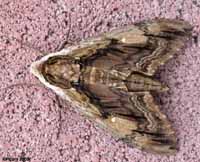 |
Ceratomia amyntor
WO,
the Elm Sphinx or Four-horned Sphinx:
The upperside of the forewing is brown with dark brown and white markings including a white costal area near the wing base, dark streaks along the veins,
and a white spot in the cell.
Larvae feed on Elm (Ulmus), birch (Betula), basswood (Tilia), and
cherry (Prunus). |
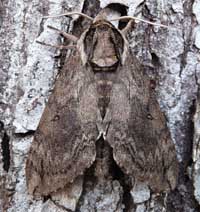 |
Ceratomia catalpae
WO,
the Catalpa Sphinx:
The upperside of the forewing is yellowish brown with no white markings, but there are indistinct black lines and dashes. The cell spot is gray with a black outline. The larvae feed in large groups and are much more
spectacular than the moths.
Catalpa is the larval host. |
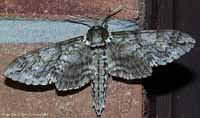 |
Ceratomia undulosa
WO, the Waved
Sphinx:
The upperside of the forewing is pale brownish gray with wavy black
and white lines and a black-outlined white cell spot. The upperside
of the hindwing is gray with diffuse darker bands. |
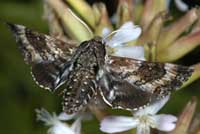 |
Dolba hyloeus
WO, the Pawpaw Sphinx:
The upperside of the forewing is dark brown with a dusting of white
scales. Some moths have patches of reddish or yellowish brown on the
wings.
|
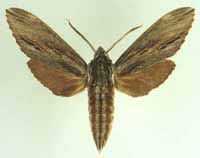 |
Isoparce cupressi
WO, the Cypress or Baldcypress Sphinx:
Isoparce cupressi, the rare Cypress Sphinx, flies in Cypress swamps in Georgia (specimen type locality), and from Maryland to Texas.
It has been reported in Mexico. possibility
|
 |
Lapara coniferarum
USGS, the Southern Pine Sphinx:
The upperside is of the forewing is gray with two
(sometimes one or three) black dashes near the wing center;
other markings are usually diffuse. The upperside of the hindwing is
a uniform brown-gray.
If you've got pines, this species is likely present.
|
 |
The upperside of forewing is gray to grayish brown with a black line
running from the middle of the costa to the middle of the outer
margin; the line may be broken near the margin. There is a splash of
brown around the cell spot.
|
 |
I suspect if you grow tomatoes, you are likely to encounter Manduca quinquemaculata.
|
 |
Look for three large yellow spots
on each side of the abdomen. The upperside of the forewing is
yellowish brown to deep chocolate brown with a dusting of white
scales and zigzagged black and white lines.
|
 |
If you grow tomatoes, you have probably encountered Manduca sexta
in the larval stage.
Larvae get very large and can strip a tomato plant.
|
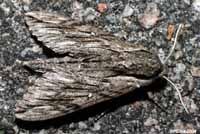 | The upperside of the forewing is gray with indistinct black and
white markings. There is a series of black dashes
from the base to the tip, and a small white cell spot.
|
Smerinthini Tribe:
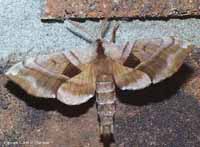 |
Amorpha juglandis
WO,
the Walnut Sphinx:
The adults are also highly variable; sometimes wings of an individual
may be all one color or may have several colors, ranging from pale to
dark brown, and may have a white or pink tinge. Patterns range from
faint to pronounced.
See the file for the female; she is different. |
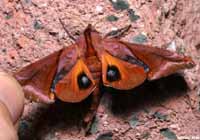 |
Paonias astylus flies from March-September in Florida and from
April-September in Louisiana. There is one brood northward from
June-August.
This appears to be an uncommon species.
|
 |
Named for the dull grey-blue spot (minus dark pupil) in the hindwing,
this moth has a wide distribution in the eastern United States.
I regularly see them on Prince Edward Island, and they are reported
as far south as Florida.
|
 |
Paonias myops
USGS, the Small-eyed Sphinx
Named for the small eye-spot in the hindwing, this moth has a wide
distribution and is probably common in Wakulla County.
I regularly see them on Prince Edward Island, and they are reported
as far south as Florida.
|
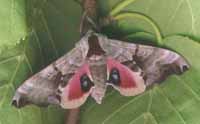 |
This moth is widely distributed and fairly common.
Along the East Coast, it flies from P.E.I. to Florida.
|
Macroglossinae subfamily
Dilophonotini tribe:
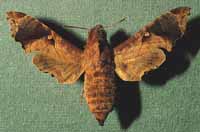
|
Enyo lugubris, the Mournful Sphinx,
WO:
The body and wings are dark brown. The forewing has a large black
patch covering most of the outer half of the wing. There is a pale
tan cell spot (dark inner pupil), and a fairly straight median line
to the inside of the cell spot.
|
 |
Erinnyis obscura, the Obscure Sphinx,
WO:
During the night adults nectar at flowers, including bouncing bet
(Saponaria officinalis) and Asystasia gangetica beginning at dusk.
July and August are flight times in the southern states. stray
|
See Hemaris comparison to help distinguish
the next three species.
 |
Hemaris gracilis
WO,
Slender Clearwing, Graceful Clearwing:
This day-flying moth is less common and has not been recorded in
Bibb County, but it may be present. unlikely
|
 |
Hemaris thysbe
BAMONAWO, the Hummingbird Clearwing:
It is not difficult to see why many gardeners would mistake an
Hemaris thysbe moth for a small hummingbird as it hovers,
sipping nectar from flowers through a long feeding tube.
|
 |
Hemaris diffinis
WO,
Snowberry Clearwing or Bumblebee Moth:
Adults mimic bumblebees; quite variable. Wings: basically clear, with dark brown to
brownish-orange veins, bases, edges. Thorax: golden-brown to
dark greenish-brown. Abdomen tends to be dark (black) with 1-2
yellow segments before tip.
|
Philampelini tribe:
 |
Eumorpha achemon
WO,
the Achemon Sphinx:
Larvae get large and feed on grape vines and Virginia creeper.
Note the differences between this moth and the Pandorus Sphinx. |
 |
Eumorpha fasciatus
BAMONA, the Banded Sphinx
The upperside of the moth is dark pinkish brown. Each forewing has a
lighter brown band along the costa, and sharp pinkish white bands and
streaks. Larvae feed upon primrose-willow, Ludwigia (water primrose)
and other plants in the evening primrose family.
|
 |
Eumorpha intermedia
WO, the Intermediate Sphinx
The Intermediate Sphinx Moth, (Eumorpha intermedia), (Wing span: 3 9/16 - 3 7/8 inches (9 - 9.8 cm)), flies in lower austral and subtropical lowlands in North Carolina,
Florida, Georgia,
Mississippi, Louisiana, and South Texas.
|
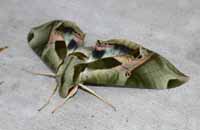 |
Eumorpha pandorus
WO, the Pandorus Sphinx:
If you have Grape or Virginia Creeper nearby, then you probably have
this species.
I often get asked to identify larvae from areas not
previously reported. |
Macroglossini tribe:
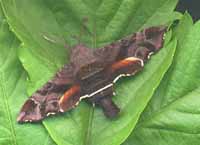 |
Amphion floridensis
WO,
the Nessus Sphinix:
This day flier is widely distributed. If you have Virginia Creeper, you
probably have the Nessus Sphinx.
Two bright, distinct, narrow yellow
bands are often visible on the abdomen.
|
 |
Darapsa choerilus
WO, the Azalea Sphinx:
The lower wings of this hawkmoth are a solid brownish-orange,
matching the body colour.
You will often see this species listed as Darapsa pholus,
especially in older literature.
|
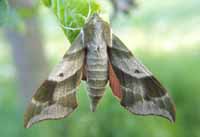 |
Darapsa myron
WO, the Virginia Creeper Sphinx or the Grapevine Sphinx:
If you have the
foodplants indicated in the common names, you probably have this
species nearby. The lower wings are orange.
|
 |
Darapsa versicolor
WO,
the Hydrangea Sphinx:
If you have hydrangea growing near a stream, then you might have the
Hydrangea Sphinx.
|
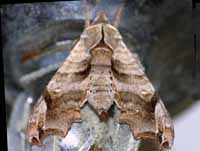 |
Deidamia inscriptum
WO,
the Lettered Sphinx:
The moth's outer margin of the forewing is deeply scalloped.
The upperside is light brown with dark brown markings.
There is a small black and white spot near the tip.
Grape (Vitis), ampelopsis (Ampelopsis), and Virginia creeper
(Parthenocissus) all serve as larval hosts.
|
 |
Hyles lineata
WO, the White-lined Sphinx
This species has
strong migrating tendancies from much further south.
There are records from New Hampshire and Maine. |
 |
Sphecodina abbottii
WO,
the Abbott's Sphinx:
This moth is very much under reported across the United States. It
is a rapid day flier so is probably not in too many collections.
Grape is a popular larval host.
|
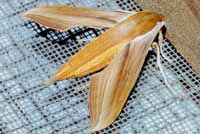 |
Xylophanes tersa
BAMONA,
the Tersa Sphinx:
This moth is much more common to the south. It is a strong migrant,
however, and is probably well established in Bibb County.
|
|
|

